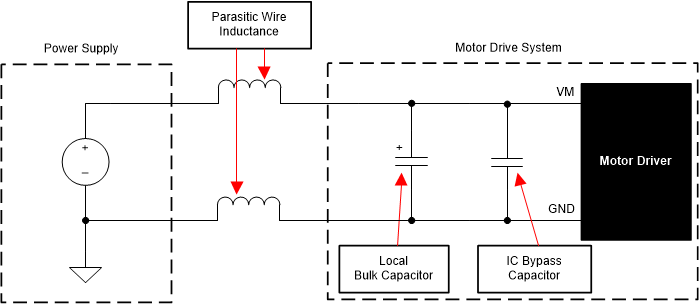ZHCSOU8B August 2021 – February 2022 MCT8316A
PRODUCTION DATA
- 1 特性
- 2 应用
- 3 说明
- 4 Revision History
- 5 Device Comparison Table
- 6 Pin Configuration and Functions
- 7 Specifications
-
8 Detailed Description
- 8.1 Overview
- 8.2 Functional Block Diagram
- 8.3
Feature Description
- 8.3.1 Output Stage
- 8.3.2 Device Interface Modes
- 8.3.3 Step-Down Mixed-Mode Buck Regulator
- 8.3.4 AVDD Linear Voltage Regulator
- 8.3.5 Charge Pump
- 8.3.6 Slew Rate Control
- 8.3.7 Cross Conduction (Dead Time)
- 8.3.8 SPEED Control
- 8.3.9 Starting the Motor Under Different Initial Conditions
- 8.3.10 Motor Start Sequence (MSS)
- 8.3.11 Closed Loop Operation
- 8.3.12 Speed Loop (Available only in MCT8316AV)
- 8.3.13 Input Power Regulation (Available only in MCT8316AV)
- 8.3.14 Anti-Voltage Surge (AVS)
- 8.3.15 Output PWM Switching Frequency
- 8.3.16 Fast Start-up (< 50 ms)
- 8.3.17 Fast Deceleration
- 8.3.18 Active Demagnetization
- 8.3.19 Motor Stop Options
- 8.3.20 FG Configuration
- 8.3.21
Protections
- 8.3.21.1 VM Supply Undervoltage Lockout
- 8.3.21.2 AVDD Undervoltage Lockout (AVDD_UV)
- 8.3.21.3 BUCK Undervoltage Lockout (BUCK_UV)
- 8.3.21.4 VCP Charge Pump Undervoltage Lockout (CPUV)
- 8.3.21.5 Overvoltage Protection (OVP)
- 8.3.21.6 Overcurrent Protection (OCP)
- 8.3.21.7 Buck Overcurrent Protection
- 8.3.21.8
Cycle-by-Cycle (CBC) Current Limit (CBC_ILIMIT)
- 8.3.21.8.1 CBC_ILIMIT Automatic Recovery next PWM Cycle (CBC_ILIMIT_MODE = 000xb)
- 8.3.21.8.2 CBC_ILIMIT Automatic Recovery Threshold Based (CBC_ILIMIT_MODE = 001xb)
- 8.3.21.8.3 CBC_ILIMIT Automatic Recovery after 'n' PWM Cycles (CBC_ILIMIT_MODE = 010xb)
- 8.3.21.8.4 CBC_ILIMIT Report Only (CBC_ILIMIT_MODE = 0110b)
- 8.3.21.8.5 CBC_ILIMIT Disabled (CBC_ILIMIT_MODE = 0111b or 1xxxb)
- 8.3.21.9 Lock Detection Current Limit (LOCK_ILIMIT)
- 8.3.21.10 Thermal Warning (OTW)
- 8.3.21.11 Thermal Shutdown (TSD)
- 8.3.21.12 Motor Lock (MTR_LCK)
- 8.3.21.13 Motor Lock Detection
- 8.3.21.14 IPD Faults
- 8.4 Device Functional Modes
- 8.5 External Interface
- 8.6 EEPROM access and I2C interface
- 8.7 EEPROM (Non-Volatile) Register Map
- 8.8 RAM (Volatile) Register Map
- 9 Application and Implementation
- 10Power Supply Recommendations
- 11Layout
- 12Device and Documentation Support
- 13Mechanical, Packaging, and Orderable Information
10.1 Bulk Capacitance
Having an appropriate local bulk capacitance is an important factor in motor drive system design. It is generally beneficial to have more bulk capacitance, while the disadvantages are increased cost and physical size.
The amount of local capacitance needed depends on a variety of factors, including:
- The highest current required by the motor system
- The capacitance and current capability of the power supply
- The amount of parasitic inductance between the power supply and motor system
- The acceptable voltage ripple
- The type of motor used (brushed DC, brushless DC, stepper)
- The motor braking method
The inductance between the power supply and the motor drive system limits the rate at which current can change from the power supply. If the local bulk capacitance is too small, the system responds to excessive current demands or dumps from the motor with a change in VM voltage. When adequate bulk capacitance is used, the VM voltage remains stable and high current can be quickly supplied.
The data sheet generally provides a recommended value, but system-level testing is required to determine the appropriate bulk capacitor.
 Figure 10-1 Example Setup of Motor Drive System With External Power Supply
Figure 10-1 Example Setup of Motor Drive System With External Power SupplyThe voltage rating for bulk capacitors should be higher than the operating voltage, to provide margin for cases when the motor transfers energy to the supply.